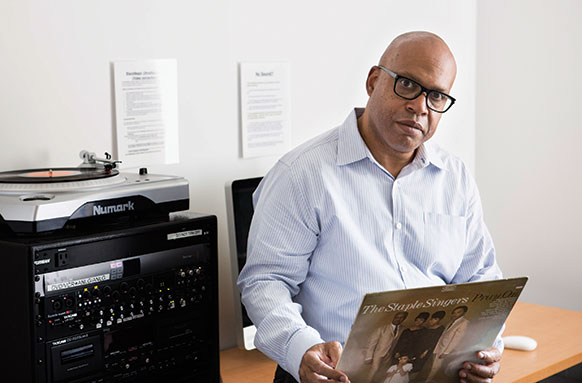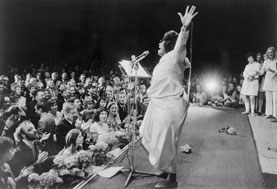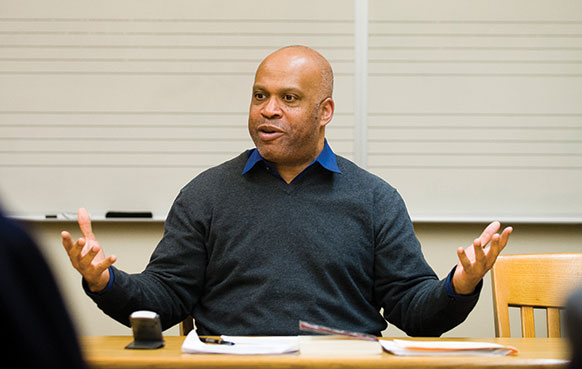
IRIS login | Reed College home Volume 93, No. 3: September 2014
The Sound of the Spirit

Professor Mark Burford in the listening room in the Performing Arts Resource Center. Photo by Daniel Cronin
Prof. Mark Burford explores one of America’s most distinctive musical traditions
By Bill Donahue
It may have been the most politically incorrect nightclub of all time.
Situated in Times Square, among Manhattan’s swankiest theatre houses and restaurants, the Sweet Chariot opened in April 1963 to deliver white patrons the rousing spectacle of African American gospel choirs belting out spirituals with histrionic flourish. The singers were told to “act just like we were in church,” one vocalist remembers, with “all the shouting and the praising and the ‘Hallelujahs’.” The doormen wore choir robes and the waitresses, called Angels, were dressed up like Playboy bunnies in fetching white stockings, racy tunics, sequined wings, and wired halos. The drinks bore names like “Deacon’s Punch” and “Dastardly Demon,” and the club attracted celebrity customers such as Frank Sinatra and Barbra Streisand, while the hoi polloi waited hours for admission and then shelled out five dollars apiece to rent tambourines for the evening.

The powerful contralto Mahalia Jackson (1911-1972) was a civil-rights icon and a key figure in the history of gospel. © Bettmann/CORBIS
The New York Times cringed at the Chariot, intoning, “It is difficult to avoid a holier-than-thou attitude toward this anomalous mixture of the spiritual and the tawdry.” Meanwhile, singer Mahalia Jackson, the grande dame of postwar gospel music, was so disgusted that she joined black preachers on a picket line outside the club, carrying enough clout to shut the place down after only six months in business. “They’re making a mockery of the most precious thing in the world—the salvation of God,” Jackson told reporters.
After all the hue and cry, the Chariot became a sad asterisk of history. Its brief, wild ride signaled nothing more than pure blaxploitation. Except to Prof. Mark Burford [music 2007–]. Burford wondered what it was about the Chariot that enchanted white America at a time when Bull Connor was using fire hoses and police dogs against child protestors in Birmingham and Martin Luther King Jr. sat in jail.
On sabbatical this year, Burford is writing a book, Receiving the Spirit: Doing Black Gospel in Postwar America, about the “mainstreaming” of black gospel singing in the U.S. between 1945 and 1963, when an ancient musical form, which began with Negro spirituals, blossomed and became a galvanizing force in the civil rights movement. In addition to focusing on the Chariot, Receiving the Spirit will linger on the career of Mahalia Jackson. It will look at singer Sam Cooke, who began his career as the front man for a rollicking gospel band, the Soul Stirrers, before becoming a velvety-smooth top-selling balladeer, and it will also consider a Chicago-area gospel TV program, Jubilee Showcase.
The research will not be easy, for gospel may be the least documented form of American music. During the golden age of gospel, roughly the two decades after World War II, major newspapers almost never wrote about gospel. Reviews and previews scarcely existed. “If you wanted to know what was going on in gospel music,” says Burford, “you’d have to go to the barbershop and say, ‘Hey, Ed, any good shows coming up?’”
To research Receiving the Spirit, Burford will travel to Chicago, to rewatch Jubilee tapes he studied in 2012, and to the Historic New Orleans Collection, where he will look through 100 crates of documents and recordings compiled by Mahalia Jackson’s personal assistant, Bill Russell. He may also make a side trip to Alabama, to sing with a gospel quartet there, the Birmingham Sunlights. “I’ve been in touch with those guys,” Burford says. “I’ve been threatening to come down for a visit.”
Burford—who focuses on music history at Reed—has never sung gospel. As he grew up in San Francisco, his parents were Seventh-Day Adventists. They went to church, but, he says, “The worship was pretty staid. People said ‘Amen’ at the end of a song and moved on. If anyone ever clapped to the beat of a hymn, everyone would give them a look.” Burford learned his singing outside church, by joining the San Francisco Boys Chorus and traveling with that ensemble to England and Israel. In time, he joined the San Francisco Symphony Chorus, and also helped start the Goleta Waters Blues Quartet. “Some nights,” he remembers, “I’d perform a Mahler symphony in a tux, and then race to the club and change backstage to play blues.”
Burford arrived at gospel quite circuitously, moving backwards through time. “In high school,” he says, “I listened to a lot of reggae, and I wanted to know where that music came from.” He began listening to rocksteady artists like Alton Ellis. This led him back to soul performers such as Otis Redding and Sam Cooke, and soon, as a college student, he was collecting gospel LPs. “It was the singing that drew me in,” he says. I was struck by how, with very subtle nuances in phrasing, each singer could make himself immediately identifiable.”
Eventually, Burford honed a taste for “going to small black churches in the middle of nowhere. The program would start two hours late,” he remembers, “and it would go to God knows when. I didn’t feel like a voyeur and I didn’t feel like I had a special privilege to be there because I’m black. I just listened.” He was stirred most at the United House of Prayer, in Washington, D.C., where two bands, each composed of 15 trombones, alternated during the service. “Their playing was no-holds-barred, and yet they had incredible mastery,” he says. “It was not an ephemeral experience. It wasn’t casual. That music really mattered to the people in that room—so much that there were nurses on hand, dressed in white, ready in case someone passed out.”
In the late ’90s, Burford wrote a PhD dissertation on the classical composer Johannes Brahms. He didn’t turn his scholarly sights on gospel until one evening in 2005. While record shopping online, he discovered an album, BB King Sings Spirituals, and then another, Nat King Cole Sings Spirituals. Why, he wondered, were these secular stars dabbling in gospel? By the time he arrived at Reed in 2007, he had a host of questions about gospel’s intersection with popular culture. And also a sense of how little research has been done on gospel.
Robert Darden, an associate professor of journalism at Baylor University and the director of Baylor’s Black Gospel Music Restoration Project, is being optimistic when he guesses that there are a couple dozen U.S. scholars focused on gospel music. “There just isn’t much material to work with,” he says, noting that during gospel’s heyday, “very few African Americans went to college, so there were few people writing things down. There were no black TV stations, and blacks hardly even appeared on TV.” What’s more, he says, gospel music is evangelical. “Some people don’t like that,” Darden says, “so while there is an Institute of Jazz Studies, and a national institute for blues and for country, there isn’t one for gospel. And there’s no academic journal either.”
Numerous histories of gospel exist—Darden’s People Get Ready, for instance. But as Burford sees it, these books have aimed mainly to “show that gospel is a unique cultural product created by African Americans.” They’ve presented an argument for black citizenship in American culture. They’ve made clear that gospel gave gravitas to the civil rights movement, and they’ve proved convincing. “They’ve freed me up to take a ‘post-soul’ approach in my writing,” Burford says, “and to be critical, rather than just celebratory, and broader in what I consider political.”
Burford encourages his students to invoke the same critical take. Last year, when he taught Music 364, “The Blues: Forms, Styles, Meanings,” he told students, “The record tends to skip when we write the history of American music. We tell the same stories over and over.” He challenged his class to “see things from oblique angles” and then asked students to comb through old newspaper stories and advertisements to recreate the most pivotal year in blues singer Bessie Smith’s career—1923, when she began recording.
Zuben Scott ’16 pored over stories from papers like the Baltimore Afro-American and the Chicago Defender. He traced Smith’s rise from a nobody to (as Scott puts it) “a symbol of the South due to her southern, vaudeville roots.” He enjoyed “discovering what seemed like unimportant advertisements and realizing their greater significance. I learned exactly what it takes to be a music historian,” he says.
Burford says that teaching about black music at Reed is at once challenging and rewarding. “Questions of race are very difficult to grapple with—more so than gender or even class,” he argues. “Sometimes white students can feel implicated when you talk about blacks—they feel guilty. At first, I just ask them to listen to the music. The music is a way into the labyrinth. Critical thinking is a way out.”
![]()

“The record tends to skip when we write the history of American music,” says Prof. Burford. “We tell the same stories over and over.”
Photo by Leah Nash
Many gospel historians don’t seem to think that the Sweet Chariot deserves much attention. In Uncloudy Days: The Gospel Music Encyclopedia, historian Bill Carpenter dismisses the Chariot’s “antics” and “buffoonery” before extensively quoting Mahalia Jackson’s diatribe against the singers. (“What’s wrong with these Negroes?” she asked.) In a draft chapter of Receiving the Spirit, Burford takes a different tack, delivering the Chariot’s employees as complex characters, at once jubilant and pained in their reminiscing. Kenneth Corprew, a Chariot singer, tells Burford that he left a $75 a week job as a court typist in Philadelphia for a $200 paycheck and the “glitz and glamour” of life at the Chariot. Speaking of the club’s managers, Corprew laments, “They did not want us to sing anything that had to do with the blood of Jesus.”
In his book, Burford restrains judgment—and also takes on accepted wisdom, such as the notion that, in becoming a pop star, Sam Cooke sold out. In a recent article, Burford casts Cooke as an agent, not a pawn, and he brings us into Cooke’s mind, quoting the singer as he revels (in 1960) over how his shrewd entrepreneurialism has opened doors for him: “My goal is to someday be in the same singing league with Harry Belafonte, Dean Martin, and Frank Sinatra. But whether I achieve my goal or not, I have organized my career on a business-like basis and I know there will be well-paying jobs waiting for me even if my records stop selling.”
It’s not yet clear how Burford will bring out the complexities in Mahalia Jackson, a steadfastly devout woman who refused to sing secular tunes, even as she deftly reached out to white audiences by adding what she called “bounce”—“a little pep,” “a little joyfulness”—to her spirituals. The scholar still has months of research to do on Jackson, for Jackson’s aide, Bill Russell, was the oddest and most obsessive of chroniclers—an accomplished violinist, a composer admired by John Cage, and a man so gospel-obsessed that in middle age he spent five years as Jackson’s volunteer errand boy. “He documented everything,” says Burford, who traveled to New Orleans for a preview look at Russell’s archives in 2012. “The entries will say, ‘Today I fixed her pipes. Here’s what she ate for lunch.’” Mixed in are rehearsal recordings and notes documenting Jackson’s unvarnished remarks on her musical colleagues as well her dealings with Columbia Records.
Most likely, a controversial figure will emerge from the archives. “As Jackson became more and more famous,” says Burford, “she became less connected with the church. She sang on the Ed Sullivan Show and on European tours and at Kennedy’s inauguration. She sang for predominently white audiences—and in the minds of many critics she became less legit. I don’t like that assessment. That’s what I’m pushing back against in the book—that orthodoxy. I think that gospel voices were everywhere in the ’50s and ’60s, and if you leave those voices out—if you don’t regard them as ‘real gospel’—well, then, you’re not telling the whole story of gospel music.”

LATEST COMMENTS
steve-jobs-1976 I knew Steve Jobs when he was on the second floor of Quincy. (Fall...
Utnapishtim - 2 weeks ago
Prof. Mason Drukman [political science 1964–70] This is gold, pure gold. God bless, Prof. Drukman.
puredog - 1 month ago
virginia-davis-1965 Such a good friend & compatriot in the day of Satyricon...
czarchasm - 4 months ago
John Peara Baba 1990 John died of a broken heart from losing his mom and then his...
kodachrome - 7 months ago
Carol Sawyer 1962 Who wrote this obit? I'm writing something about Carol Sawyer...
MsLaurie Pepper - 8 months ago
William W. Wissman MAT 1969 ...and THREE sisters. Sabra, the oldest, Mary, the middle, and...
riclf - 10 months ago